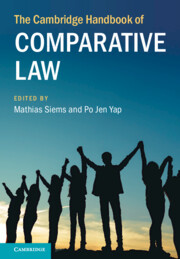Book contents
- The Cambridge Handbook of Comparative Law
- The Cambridge Handbook of Comparative Law
- Copyright page
- Contents
- Figures
- Tables
- Contributors
- Preface
- Abbreviations
- 1 Introduction
- Part I Methods of Comparative Law
- Part II Legal Families and Geographical Comparisons
- 11 Civil Law
- 12 Common Law
- 13 Confucian Legal Tradition
- 14 Former Soviet States of Eastern Europe, Caucasus and Central Asia
- 15 Latin America
- 16 Middle East and North Africa
- 17 South Asia
- 18 Sub-Saharan Africa
- Part III Central Themes in Comparative Law
- Part IV Comparative Law beyond the State
- Index
17 - South Asia
from Part II - Legal Families and Geographical Comparisons
Published online by Cambridge University Press: 26 January 2024
- The Cambridge Handbook of Comparative Law
- The Cambridge Handbook of Comparative Law
- Copyright page
- Contents
- Figures
- Tables
- Contributors
- Preface
- Abbreviations
- 1 Introduction
- Part I Methods of Comparative Law
- Part II Legal Families and Geographical Comparisons
- 11 Civil Law
- 12 Common Law
- 13 Confucian Legal Tradition
- 14 Former Soviet States of Eastern Europe, Caucasus and Central Asia
- 15 Latin America
- 16 Middle East and North Africa
- 17 South Asia
- 18 Sub-Saharan Africa
- Part III Central Themes in Comparative Law
- Part IV Comparative Law beyond the State
- Index
Summary
This chapter examines the development of public law in South Asia: a legal family that has been defined by its history of British colonialism and continued adherence to the common law legal tradition. It traces the evolution of constitutionalism in four countries – India, Bangladesh, Pakistan and Sri Lanka – since their independence from Britain, focusing on two common regional themes. The first is the judicialisation of politics through the adoption (or at least consideration) of the basic structure doctrine, which permits courts to define and enforce implicit limits on constitutional amendments. The second is the centralisation (and abuse of) executive power, which has imperilled democratic rule in all four countries. While neither of these developments is specific to South Asia, the interplay between them, resulting in separate spheres of unchecked judicial and executive domination, is perhaps unique to the region and warrants further attention from comparative scholars.
- Type
- Chapter
- Information
- The Cambridge Handbook of Comparative Law , pp. 343 - 366Publisher: Cambridge University PressPrint publication year: 2024

